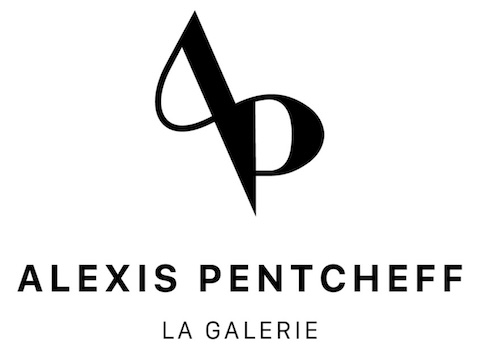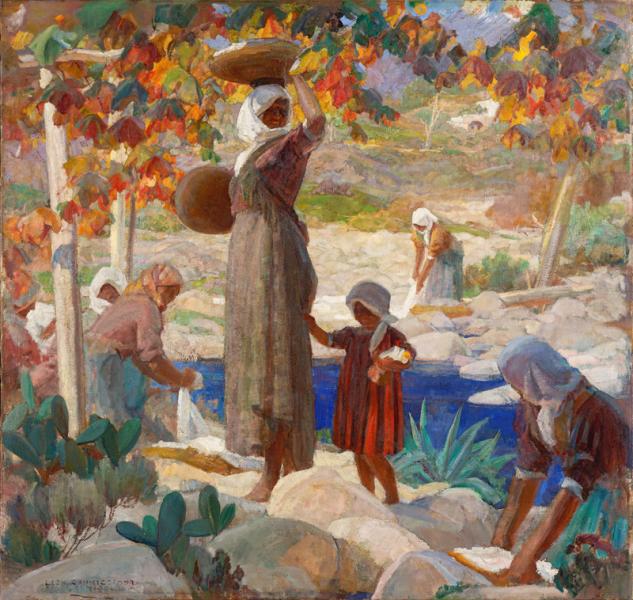Femmes corses à la fontaine, c.1924
Oil on canvas, signed lower left.
138 x 143 cm
Provenance :
Collection privée, France
THE MYSTERIOUS ISLAND
Canniccioni's childhood was marked by the aura of a truly self-taught poet, a former shepherd from Moltifao exiled from his native land at the end of the 19th century: his father Xavier Canniccioni, who, to earn a living in Paris where he eventually settled, published articles in newspapers under the pseudonym "Canny". The son's artistic choices went unchallenged, although the family knew what it cost to embark on a career of this nature.
By 1893, the young man was already attending the Ecole des Arts Décoratifs, before taking part in the free workshop taught by Jean Léon Gérôme. Then, more officially, he was one of Gérôme's students at the Ecole des Beaux-Arts, where he was enrolled from 1899 onwards, winning several end-of-cycle awards (three medals for large painted figures and five medals for painted sketches, to be precise). Canniccioni was also a pupil of another renowned artist, genre painter and portraitist Gabriel Ferrier, with whom he honed his skills in composition and figure treatment.
From 1909, the painter exhibited at the Salon des artistes français. He was represented there until the 1940s, never deviating from the official path in the career he was gradually building. Honors and success were to come, starting with a travel grant in 1911 (for his painting Le retour à la terre, now in the Ajaccio museum). Many other awards followed.
In the 1920s, the State acquired several of his works, and the painter also built up an important network of acquaintances and collectors who appreciated his work and enabled him to make a comfortable living from it. These included the tenor Lucien Muratore, the jeweller Mellerio and even the senator and future president Paul Doumer. He made frequent trips to North Africa, whose rugged landscapes inspired him, and of course to Corsica, to his father's birthplace in Moltifao and Ajaccio.
Historical subjects, favored in his submissions to the Salon since the end of his training, gradually gave way to more picturesque themes, appealing to the memory of his roots. Corsica was his main source of inspiration. Through his representations, Canniccioni became an ambassador for the island and its traditions. Inland, as in the village of Moltifao, Corsica is even more secretive, shrouded in the mystery of its rituals. Work in the fields or vineyards - in other words, rural life inland - is punctuated by religious celebrations: masses, processions, funerals... Canniccioni likes to paint these moments of village life with a kind of solemnity that suits them. Even in the case of more joyful events such as the grape harvest, Canniccioni's treatment conveys a sense of intense gravity. In this way, his brush captures the weight of the Corsican people's soul, the power of their heritage.
Les Femmes corses à la fontaine, the title (inscribed on the back of the stretcher) given by the painter to the work we present, reveals one of Canniccioni's favorite themes. By a river, rather than a fountain, a group of women wash their white linen. All are bent over their work, except one, in the center of the composition, who draws the light onto her white kerchief. Of tall, upright stature, she proudly carries the jug, a secchia, which she holds over her head with her folded arm, and in this position, this figure has all the makings of ancient sculpture (except that she is more clothed). A little girl clings to her petticoats.
This all-female universe, recreated around a river, is reminiscent of a mythological power, which is intended to be of noble chastity. As is often the case with Canniccioni's work, the faces are turned away or only slightly evoked, adding to the expressive power of the scene. The tonalities are autumnal, in the restrained yet powerful palette that characterizes his work, whose oscillations are ensured by a particular attention to light, proof of a sure hand. This version of Femmes corses à la fontaine is a variation on a painting that won the artist a gold medal at the Salon des artistes français in 1924. There are few differences between the two works, apart from the presence of the little girl in her mother's skirt. Could this be a special request from a patron?
From the 1940s onwards, the painter's popularity declined, as did his health. He was bereaved by the loss of his beloved wife, and his name as an artist no longer really circulated among collectors, who had turned the page on the official Salons.
Aged, hemiplegic and old-fashioned for the post-war period, he returned to Corsica in the early 1950s, a man out of step with the times. Lost in nostalgia, he bemoans the island's new lifestyles, which in some ways have tipped over into motorized modernity.
Canniccioni was thus one of the last witnesses to the age-old mysteries of inland Corsica, before the avatar of the consumer society we've been living since the second half of the 20th century reached the island's shores. A man of a bygone age, he is the custodian of a long tradition of codes and rites, steeped in mystery and magic, in which exiled shepherds are also poets.

